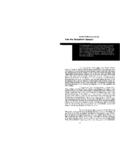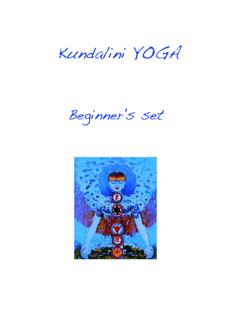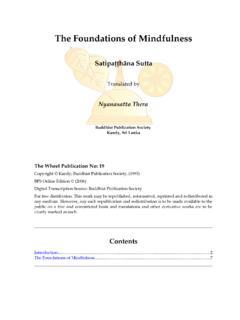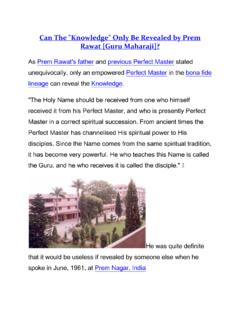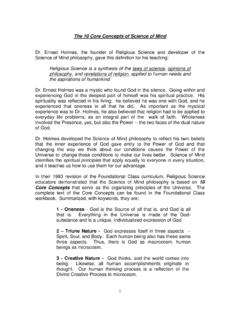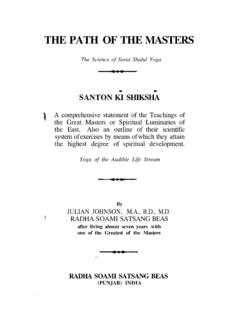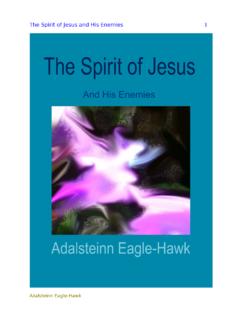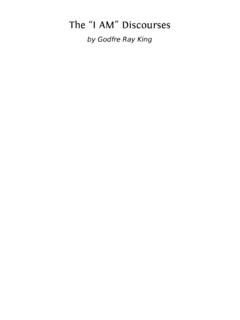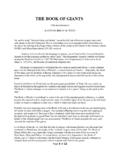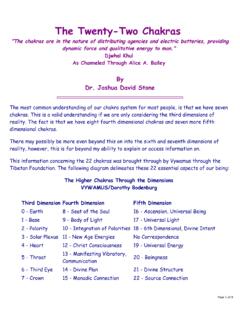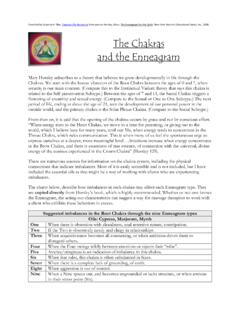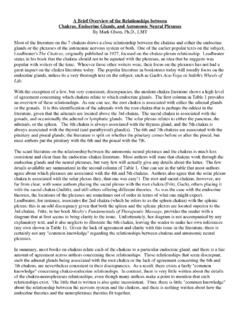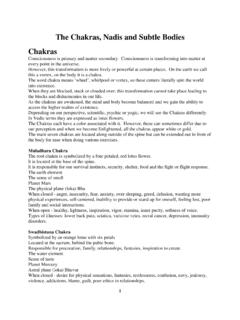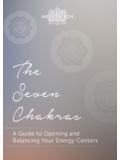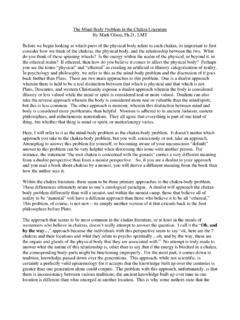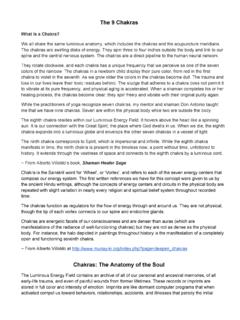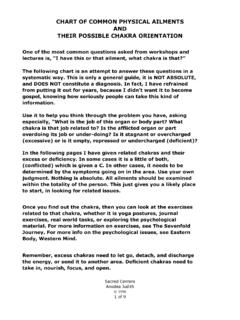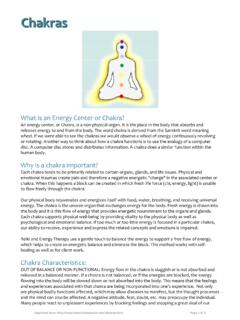Transcription of Chakras Page 1 of 17 SAT-CHAKRA-NIRUPANA (By …
1 SAT-CHAKRA-NIRUPANA (By Purnananda Swami) 7 Chakras Contents Editor's Introduction 1. Muladhara chakra 2. Svadhisthana Chakra3. Manipura chakra 4. Anahata chakra 5. Vishuddha chakra Page 1 of 17 Chakras1/21/2009 Editor's Introduction Muladhara chakra 6. Ajna chakra 7. Sahasrara 8. Kundalini BOOKSTORES ARE FILLED today with paperbacks that describe the Chakras , the energy centers through which Tantric yogis guide the Kundalini to attain realization. The book you are about to read is one of the earliest in that genre. It was written more than five hundred years ago in Sanskrit by a Bengali yogi named Purnananda. We know this book was highly esteemed through the centuries because it was the subject of numerous commentaries. In the early 1900s, a manuscript of this text was obtained by Arthur Avalon (Sir John Woodroffe). He translated it into English and included it as part of his famous book The Serpent Power which was first published in 1919. Avalon's translation is reproduced here exactly as it appeared in The Serpent Power.
2 However, we have omitted or changed some of his footnotes and added a few of our own. The copyright on this translation has expired. [Preliminary Verse:] Now I speak of the first sprouting shoot (of the Yoga plant) of complete realization of the Brahman, which is to be achieved, according to the Tantras, by means of the six Realization = nivarhah, lit., "accomplishment."Page 2 of 17 Chakras1/21/2009 and so forth in their proper order. 1. In the space outside the Meru, placed on the left and the right, are the two Siras, Sasi and Mihira. The Nadi Sushumna, whose substance is the threefold Gunas, is in the middle. She is the form of Moon, Sun, and Fire; Her body, a string of blooming Dhatura flowers, extends from the middle of the Kanda to the Head, and the Vajra inside Her extends, shining, from the Medhra to the Head. Meru = spinal column. Siras = nadis, , subtle channels for energy. Kanda, lit. "bulb," located in the perineum. Medhra = penis. 2. Inside her [Vajra] is Chitrini, who is lustrous with the lustre of the Pranava and attainable in Yoga by Yogis.
3 She (Chitrini) is subtle as a spider's thread, and pierces all the Lotuses which are placed within the backbone, and is pure intelligence. She (Chitrini) is beautiful by reason of these (lotuses) which are strung on her. Inside her (Chitrini) is the Brahma-nadi, which extends from the orifice of the mouth of Hara to the place beyond, where Adi-deva is. Pranava = the mantra Om. The Brahama-nadi is the hollow space inside Chitrini; they are not two separate nadis. Orifice of the mouth of Hara = the opening at the top of the Svayambhu-Linga in the Muladhara. Adi-deva = the supreme Bindu in the pericarp of the thousand-petalled lotus. 3. She [Chitrini] is beautiful like a chain of lightning and fine like a (lotus) fibre, and shines in the minds of the sages. She is extremely subtle; the awakener of pure knowledge; the embodiment of all Bliss, whose true nature is pure Consciousness. The Brahma-dvara shines in her mouth. This place in the entrance to the region sprinkled by ambrosia, and is called the Knot, as also the mouth of Sushumna.
4 Bliss = sukha. Consciousness = Suddha-bodha-svabhava. Braham-dvaram = door of Brahaman, through which Kundalini passes. Knot = Granthi-sthanam; the place where Sushumna meets Kanda. Ambrosia = Sudha; it flows from the union of Shiva and Shakti. The last sentence is reproduced accurately here from the printed original, despite its defective syntax. 4. Now we come to the Adhara Lotus. It is attached to the mouth of the Sushumna, and is placed below the genitals and above the anus. It has four petals of crimson hue. Its head (mouth) hangs downwards. On its petals are the four letters from Va to Sa, of the shining colour of gold. Adhara Lotus = Muladhara- chakra , the root chakra , the lowest one, located in the perineum. 5. In this (Lotus) is the square region ( chakra ) of Prthivi, surrounded by eight shining spears. It is of a shining yellow colour and beautiful like lightning, as is also the Bija of Dhara which is within. Prthivi = earth element. Yellow is the color of the earth element.
5 Page 3 of 17 Chakras1/21/2009 of Dhara = Bija of Prthivi, the earth Tattva or "Lam." 6. Ornamented with four arms and mounted on the King of Elephants, He carries on His lap the child Creator, resplendent like the young Sun, who has four lustrous arms, and the wealth of whose lotus-face is fourfold. This is the Dhyana of the Dhara-Bija. The Dhara-Bija is identical with that of Indra. 7. Here dwells the Devi Dakini by name; her four arms shine with beauty, and her eyes are brilliant red. She is resplendent like the lustre of many Suns rising at one and the same time. She is the carrier of the revelation of the ever-pure Intelligence. Ever-pure intelligence = sada suddha-buddeh; even people ignorant of Sanskrit can recognize the poetic quality of this phrase. By meditating on Dakini-Shakti, the presiding divinity of this region, one acquires suddha-buddheh -- , tattva-jnana or pure intelligence. 8. Near the mouth of the Nadi called Vajra, and in the pericarp (of the Adhara Lotus), there constantly shines the beautifully luminous and soft, lightning-like triangle which is Kamarupa, and known as Traipura.
6 There is always and everywhere the Vayu called Kandarpa, who is of a deeper red than the Bandhujiva flower, and is the Lord of Beings and resplendent like ten million suns. Vayu called Kandarpa = a form of apana; Kandarpa is a name of Kama, the deva of love. 9. Inside it (the triangle) is Svayambhu in His Linga-form, beautiful like molten gold, with His Head downwards. He is revealed by Knowledge and Meditation, and is of the shape and colour of a new leaf. As the cool rays ot lightning and of the full moon charm, so does His beauty. The Deva who resides happily here as in Kasi is in forms like a whirlpool. Svayambhu in His Linga-form = the self-originated in the form of a phallus. Shape and color of a new leaf = like an unopened blue-green bud, according to commentators. Knowledge = jnana Meditation = dhyana Kasi = Shiva's favorite abode; the meaning is that the deva is as happy here as he is in Kasi. "Whirlpool" refers to a depression on the top of the linga. 10 and 11.
7 Over it [Svayambhu-Linga] shines the sleeping Kundalini, fine as the fibre of the lotus-stalk. She is the world-bewilderer, gently covering the mouth of Brahma-dvara by Her own. Like the spiral of the conch-shell, Her shining snake-like form goes three and a half times round Shiva, and Her lustre is as that of a strong flash of young strong lightning. Her sweet murmur is like the indistinct hum of swarms of love-mad bees. She produces melodious poetry and Bandha and all other compositions in prose or verse in sequence or otherwise in Samskrita, Prakrita and other languages. It is She who maintains all the beings of the world by means of inspiration and expiration, and shines in the cavity of the root (Mula) Lotus like a chain of brilliant lights. "World-bewilderer" because Kundalini is maya in this world. Bandha = type of literary composition in which the verse is arranged in a diagram or picture. Page 4 of 17 Chakras1/21/2009 Svadhisthana chakra 12. Within it [Svayambhu-Linga, round which Kundalini is coiled] reigns dominant Para, the Sri-Paramesvari, the Awakener of eternal knowledge.
8 She is the Omnipotent Kala who is wonderfully skilful to create, and is subtler than the subtlest. She is the recepttacle of that continuous stream of ambrosia which flows from the Eternal Bliss. By Her radiance it is that the whole of this Universe and this Cauldon is illumined. Universe = brahmanda, , egg of Brahma Cauldon = kataha, that is, the lower half of the Brahmanada, and as such cauldron-shaped. 13. By meditating thus on Her who shines within the Mula- chakra , with the lustre of ten million Suns, a man becomes Lord of speech and King among men, and an Adept in all kinds of learning. He becomes ever free from all diseases, and his inmost Spirit becomes full of great gladness. Pure of disposition by his deep and musical words, he serves the foremost of the Devas. Foremost of the devas = Brahma, Vishnu, Shiva, etc. 14. There is another Lotus placed inside the Sushumna at the root of the genitals, of a beautiful vermillion colour. On its six petals are the letters from Ba to Puramdara, with the Bindu superposed, of the shining colour of lightning.
9 Another lotus = the Svadhisthana- chakra . Puramdara = the letter La Bindu = The Anusvara Page 5 of 17 Chakras1/21/2009 Manipura chakra 15. Within it [Svadhisthana] is the white, shining, watery region of Varuna, of the shape of a half-moon, and therein, seated on a Makara, is the Bija Vam, stainless and white as the autumnal moon. Makara = mythical animal somewhat like an alligator 16. May Hari who is within it, who is in the pride of early youth, whose body is of a luminous blue beautiful to behold, who is dressed in yellow raiment, is four armed, and wears the Sri-vatsa, and the Kaustubha, protect us! Within it: Vishnu is within the lap of the Bindu of Vam. Sri-vatsa = an auspicious curl on the breast of Vishnu and his avatar, Krishna, which symbolizes Prakriti. Kaustubha = a great gem worn by Vishnu. 17. It is here [in the Svadhisthana] that Rakini always dwells. She is of the colour of a blue lotus. The beauty of Her body is enhanced by Her uplifted arms holding various weapons.
10 She is dressed in celestial raiment and ornaments, and Her mind is exalted with the drinking of ambrosia. Dwells = bhati, lit., "shines" 18. He who meditates upon this stainless Lotus, which is named Svadhisthana, is freed immediately from all his enemies, such as the fault of Ahamkara and so forth. He becomes a Lord among Yogis, and is like the Sun illumining the dense darkness of ignorance. The wealth of his nectar-like words flows in prose and verse in well-reasoned discourse. His enemies = the six passions, , kama (lust), krodha (anger), lobha (greed), moha (delusion), mada (pride), matsarya (envy), which all arise from a sense of me-ness (ahamkara). Ahamkara = egoism. Ignorance = moha. Page 6 of 17 Chakras1/21/2009 Anahata chakra 19. Above it [the Svadhisthana], and at the root of the navel, is the shining Lotus of ten petals, of the colour of heavy-laden rain-clouds. Within it are the letters Da to Pha, of the colour of the blue lotus with the Nada and Bindu above them.
